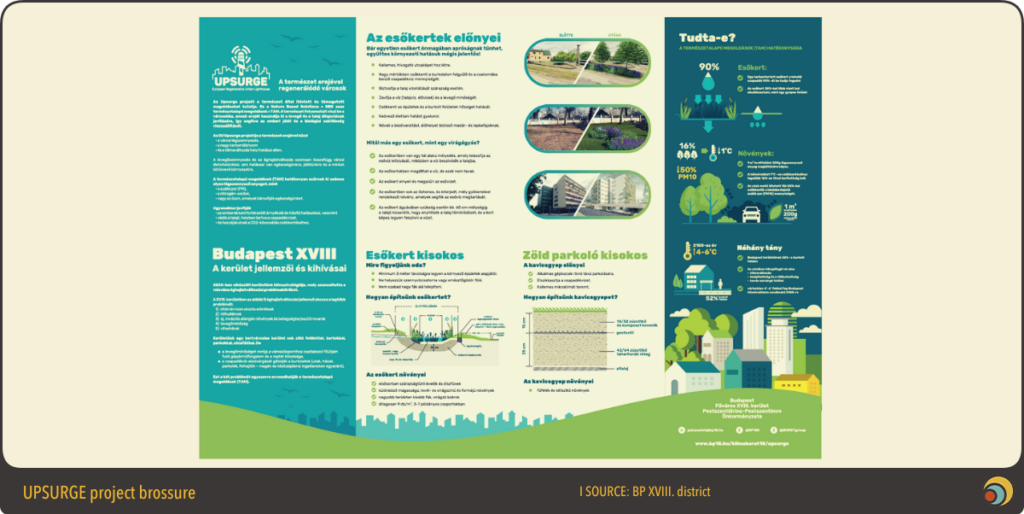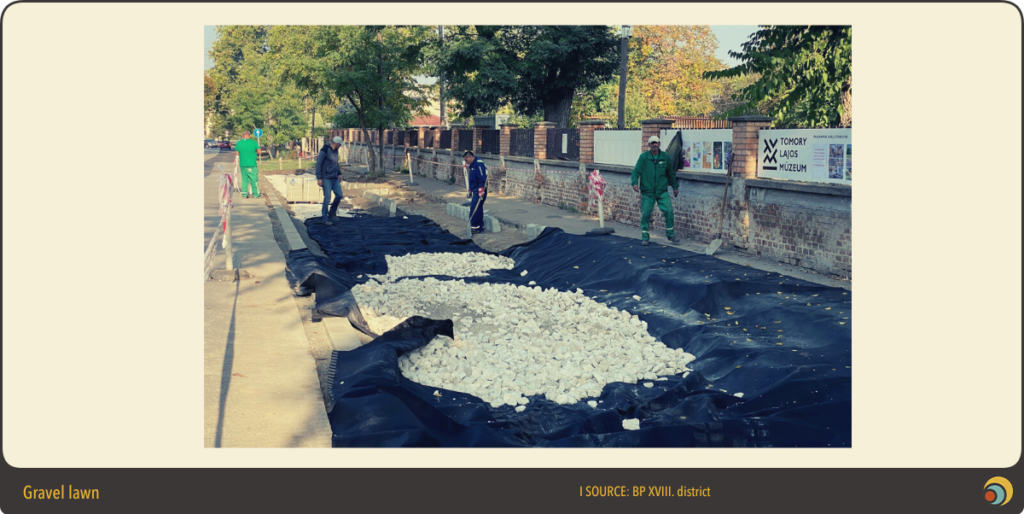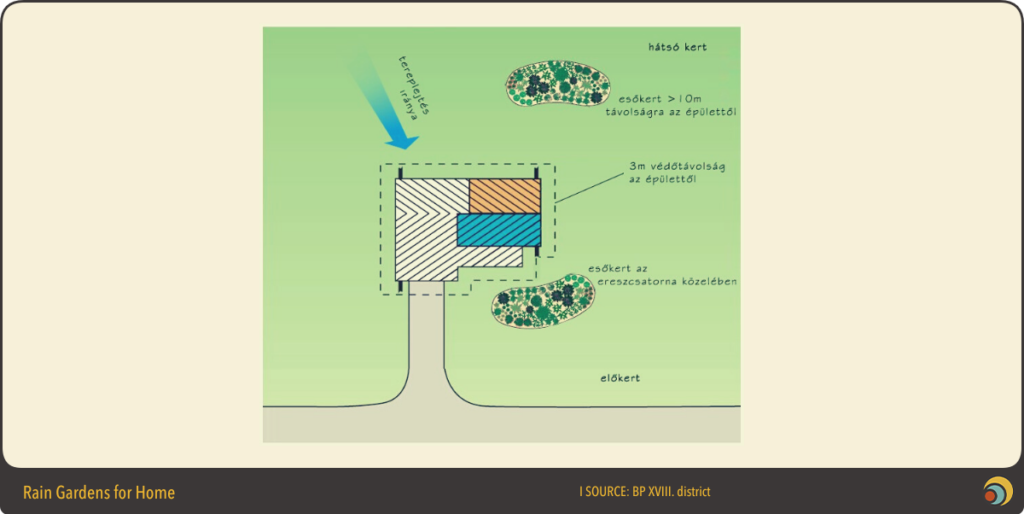Flash floods and other extreme precipitation events are increasingly affecting municipalities across Europe, who are increasingly adopting nature-based solutions (NBS) to address the problem. This is the spirit of the XVIIIth district of Budapest, where the municipality is undertaking the UPSURGE transnational project to introduce natural water retention solutions on public land and to extend the development and transformation of gardens on private land beyond the fence.
The XVIIIth district of Budapest has been actively involved in environmental protection since the 2010s, and its activities have been integrated into the municipal climate protection programme in 2020. The programme aims to respond to the complex impacts of climate change at district level, and one of its elements was the preparation of a climate strategy in 2020, taking into account local conditions. The development of the strategy was accompanied by a social mobilisation process to gather views on possible emerging nature-based solutions (NBS). As a next milestone, the district has joined the UPSURGE Horizon2020 funded project, which started in 2021 and practically implements the NBS identified in the preceding climate strategy.

Flash floods and stagnant water
The XVIII district of Budapest is characterised mainly by residential areas, with a small proportion of socialist-style tenement buildings of 10 storeys and a larger proportion of suburbs of family houses and condominiums. The urban fabric is characterised, as in most districts of Budapest, by a high degree of paved surface coverage, which prevents water run-off. Climate change has led to extreme precipitation events in recent years: this means sudden and heavy rainfall. The closed ground surface is unable to drain it adequately, resulting in flash floods in paved areas and water-logging in green areas unable to retain water – both of which are problems that need to be addressed.
BpXVIII x UPSURGE
The consortium of the UPSURGE project includes the municipality of the XVIIIth district of Budapest and BURST Nonprofit Ltd. as its ‘City Buddy”, involved to assist the district in the project. The brainstorming of the two parties resulted in two main lines of action: on the one hand, rainfall retention in public spaces, and on the other hand, encouraging residents to develop and maintain their private gardens in this way. We asked BURST’s expert, Balázs Kozák, about the activities of the project.
“The XVIIIth district of Budapest is mainly affected by the urban climate and the sudden rainfall. The joint work has shown that rain gardens on public and private land can provide a solution to the problems. The rain garden itself is not a big novelty at international level, the innovative and bold aspect is the targeting of private gardens. Until recently, there was no mention of private property at a regulatory level, as respect for it is vital in our Western culture. Now, however, a new discourse is emerging on the need for local government to have some say in the use of private green spaces for the common good – the XVIIIth district of Budapest is seeking to influence garden owners through social dialogue and awareness-raising rather than regulation as a first step.”
Rain garden and gravel paving at the Tomory Lajos Museum
The public space intervention of the project was in the area of the Lajos Tomory Museum, located in the central part of the district: on the border between a huge socialist-style housing estate and the suburban zone, next to a city garden. The function of the 34 m2 rain garden is to capture the rainwater from the city garden through the gate during heavy rainfall and to infiltrate it into the soil, providing long-term moisture for the vegetation.
The district is evaluating the first rain garden as part of a learning and fine-tuning process, and later, with the right number of rain gardens, stormwater problems in the district could be reduced to a manageable size. In addition to managing extreme rainfall events, these gardens will cool their surroundings by evaporating during heat waves.
In addition to technical implementation, the district is also working to effectively communicate its methods to sensitise the public, and to involve them in the planning process, as Balázs reports:
“A participatory planning process in all its elements is very difficult for the municipality to implement, as it is very long and requires a high degree of flexibility, with many unforeseen factors to be adjusted to along the way, which often slow down the process. It is difficult to plan when you have to build something on time. For the rain garden, which was implemented in October 2023, a public workshop had been held in February to inform the public about the plans already drawn up and to open the discussion on the choice of plant species to be planted in the rain gardens. The sensitisation element of the workshop was a spectacular demonstration comparing the water absorption capacity of a rain garden and a green area in a park.”
The rain garden itself was inaugurated in October 2023, with an open day organised by the municipality to report on the results as a conclusion to the community planning process. At the handover ceremony, a brochure was also presented and made available, which included practical information on rainfall management, highlighting the possibilities for residents to implement in their own private gardens.

The car park next to the museum building was also transformed with the help of NBS: the area used for parking on compacted soil was replaced by a so-called gravel grass pavement with no or low irrigation requirements, covered with an extensive grass seed mix.
Gravel turf is a green, percolation-active and flexible bedding of a 30-50 cm layer of crushed stone, which can be used as an alternative to asphalt or concrete paving for less frequently used parking areas. Unlike traditional paving (asphalt, concrete), gravel turf allows rainfall to infiltrate evenly into the ground and, in addition to its microclimatic benefits, it is a more pleasant-looking green surface.
Because the plant surface needs light to grow, it can be ideal for single-family homes where cars are typically not parked during the day, or for public facilities with lower traffic where parking is only for short periods.
In the area in front of the museum, 156 m2 of percolation (gravel grass pavement) has been created using a nature-based solution to retain stormwater. In addition, a total of 53 m2 of low green areas planted with ground-covering shrubs have been created.

Focus on public awareness
Another important part of the district’s efforts is to sensitise the population and to provide professional and financial incentives for the climate-adaptive transformation of private gardens.
“The objective of the project is to establish 25 rain gardens in private gardens. It will be carried out by the municipality’s own company, the Town Manager Ltd., which will build the gardens on the basis of the plans being drawn up, so that the knowledge will be incorporated into the local pool. The rain gardens in private gardens will be the subject of a call for applications – the framework and the conditions of the call for applications are being developed by the municipality and the call for applications will be launched in 2025. The UPSURGE project will fund 100% of the private gardens, so this will be an attractive option for people. The conditions of the tender will include regular feedback from residents about the gardens, and the possibility to report on them in the media, so that the good example can be spread further,” says Balázs.

The future of the NBS approach in the district
In autumn 2024, a Professional Steering Group was set up, composed of people and residents with a wide range of professional backgrounds (science/academia, economy, public sector, civil sector, etc.), who will contribute their knowledge and perspectives to shape the local and project-level knowledge of the UPSURGE project on nature-based solutions. They will contribute with their professional insights, inter alia, to the evaluation of the demonstration model projects in the XVIIIth district of Budapest and, through their suggestions, contribute to the local, national and EU discourse on nature-based solutions for their dissemination.
Balázs also gives us an insight into the future activities of the project:
” The third NBS investment will be a wooded drainage ditch that will line a 600-800 m long street section in Pestszentimre. The purpose of the tree planting is to retain rainfall in a very problematic area, and to act as a rain garden.
In the long term, beyond the project, the district aims to set up a so-called Pace Lab, which will measure the impact of the NBSs introduced and provide targeted information to the population. BURST and the cities participating in the UPSURGE projects, including the XVIIIth district of Budapest, will jointly develop a tailor-made monitoring system in each of the demonstration cities. The sensor system resulting from the design process will be installed by the cities before the end of the project, in August 2025.”
